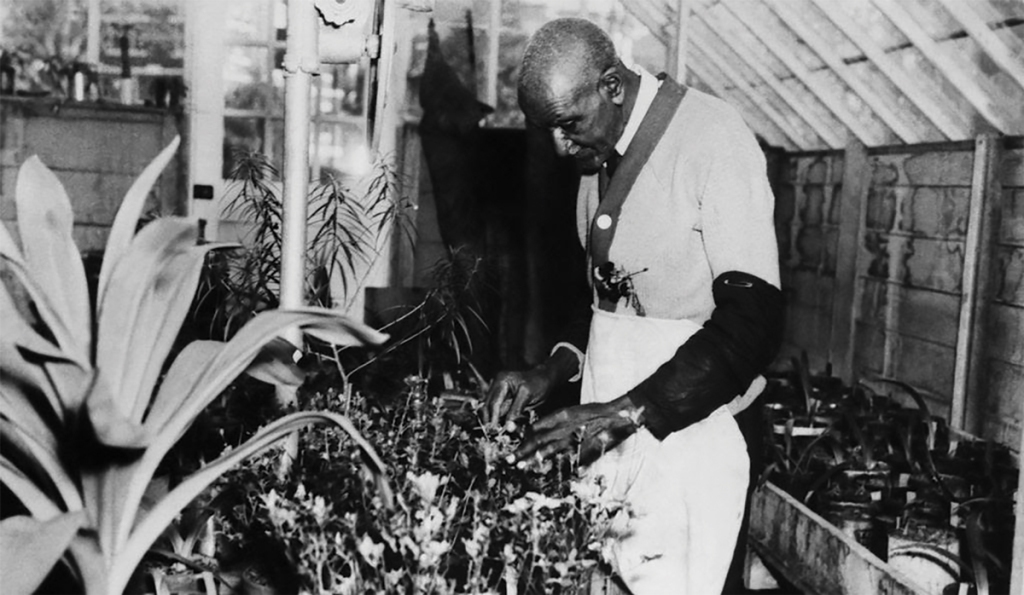 George Washington Carver in his greenhouse, conducting the kind of work that inspired “World Without End: The George Washington Carver Project,” a forthcoming exhibition for Pacific Standard Time 2024. Photo P. H. Polk/Courtesy Tuskegee University Archives
George Washington Carver in his greenhouse, conducting the kind of work that inspired “World Without End: The George Washington Carver Project,” a forthcoming exhibition for Pacific Standard Time 2024. Photo P. H. Polk/Courtesy Tuskegee University Archives
As the world of art broadens its borders and sets its sights on all realms of culture, ARTnews surveyed collaborations of various kinds for the August/September issue of the magazine. Stay tuned as roundups related to different categories—Art x Fashion, Art x Music, Art x Science, Art x Food, and Artists x Artists—join related feature stories online in the weeks to come.
PST x Scientific Intersectionality
Over the past decade, the Getty Foundation has given out a series of grants for participation in Pacific Standard Time (PST), an ambitious exhibition initiative shared among institutions across Southern California as well as creators of different kinds. The first PST, in 2011, celebrated mid-century art from Los Angeles. The second, in 2017, focused on Latin American and Latinx art. The current cycle of grantees for the next PST, in 2024, includes artists and institutions—this time from around the world, not just Southern California—selected as part of a focus on intersections between science and art.
“Getty is a scientific institution as part of our conservation program,” said Heather MacDonald, program officer at the Getty and one of the builders of the PST initiative. While considering this year’s series of grants, the theme for which was decided back in 2019, the Getty consulted with prominent scientists like Nobel Prize–winning molecular biologist David Baltimore and historian of science Jed Buchwald, both of whom are faculty members at Caltech in Pasadena.
Among the projects being supported in the current PST cycle is “World Without End: The George Washington Carver Project,” an exhibition to be presented at the California African American Museum. Besides his interest in agronomy and plant science research, Carver was an artist who derived pigments from clay and peanuts, and the show will feature work by artists, scientists, and engineers responding to his legacy. The Getty’s grant stemmed from “the sense of his ideas being so in sync with sustainable and organic agriculture,” according to MacDonald.
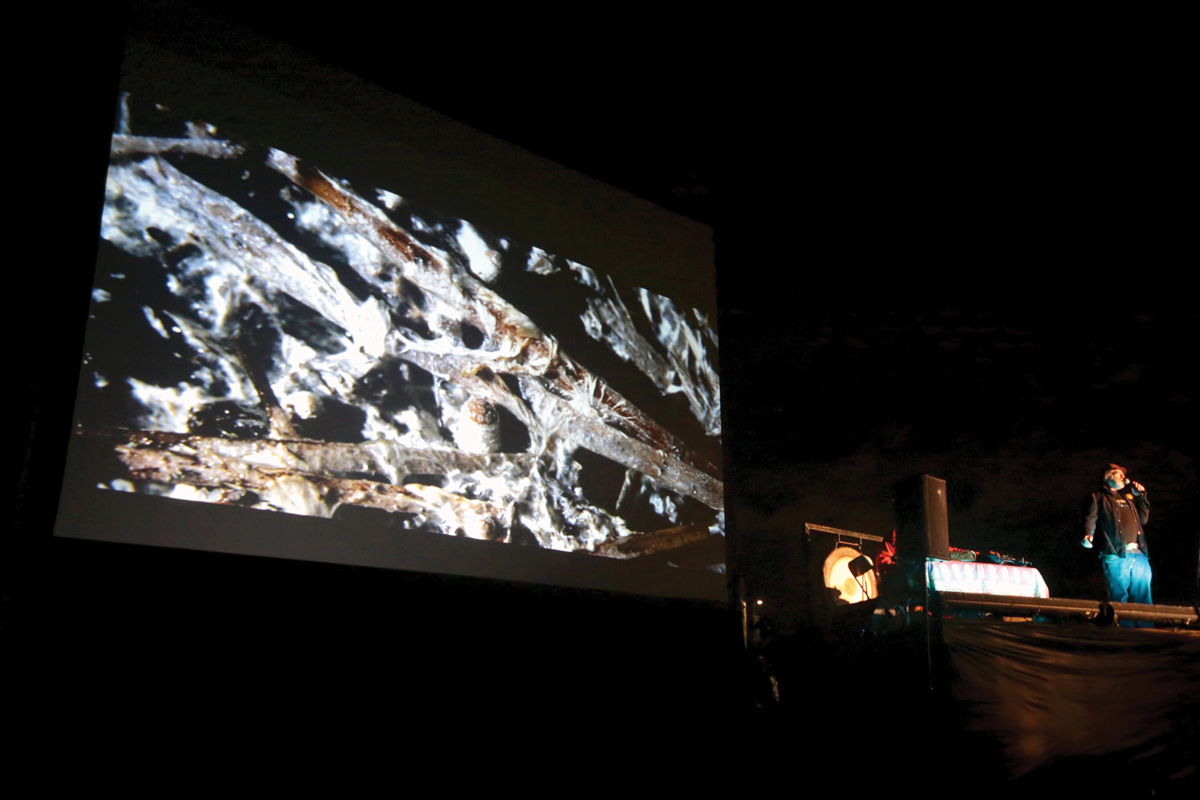 A view of Myco-Cosmos, a past performance event at Los Angeles State Historic Park, conceived and directed by artist Phil Ross and produced by Fathomers, a PST 2024 grantee. Photo Theo Jamison
A view of Myco-Cosmos, a past performance event at Los Angeles State Historic Park, conceived and directed by artist Phil Ross and produced by Fathomers, a PST 2024 grantee. Photo Theo Jamison
Another grant went to a collaboration between the Burbank-based art research institute Fathomers, a self-described “creative research institute dedicated to producing sites and encounters that challenge us to live and act differently in the world,” and the Science Gallery Detroit at Michigan State University. (Detroit is one of an eight-member network of Global Science Gallery sites around the world.) “Emergence: A Genealogy,” to be presented in fall 2024 at the Japanese American Cultural and Community Center in L.A., will function as a survey of what an exhibition description calls “bioart,” an umbrella term that “applies synthetic biology to design, sculpture, new media, performance, and social practice art.”
Antajuan Scott of the Science Gallery Detroit and Stacy Switzer of Fathomers said their collaboration will explore the history of biology and evolution—particularly the uglier sides of both that led to racist pseudo-science. The project will range from “simple things like DNA extraction demonstrations” to a “lab based inside a shipping container,” according to Switzer.
This theme of inequality in science explored through art is of a piece with a mandate of the Science Gallery Detroit. “Our job is understanding how technology and issues within the sciences such as medical disparity are affecting our community, and to present exhibitions and programs that help answer questions and provide agency within lived experiences,” Scott said. “Detroit is the blackest city in America. We would be doing ourselves an injustice if we did not think about our community first.”
Opening in November at Science Gallery Detroit is an exhibition called “Tracked and Traced,” an exploration of surveillance in the 21st century. “Think about marginalization and access but also the creation of the tools that are now becoming more pervasive and less understood within the realm of technology,” said Scott. He added that, as an institution delving into science and art together, “we are charged with investigating things a bit differently.”
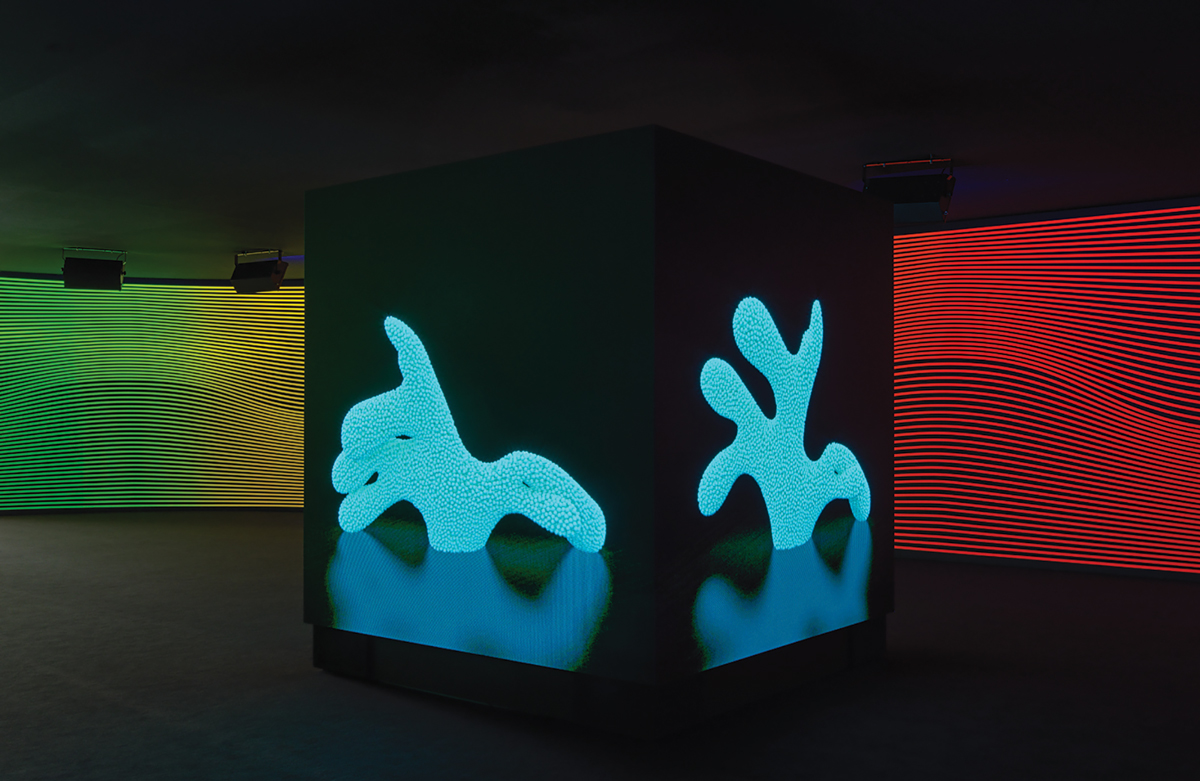 Installation view of Claudia Comte’s exhibition “After Nature” at the Thyssen-Bornemisza National Museum in Madrid. Photo Stefan Altenburger/TBA21 TBA21-Academy x Oceans
Installation view of Claudia Comte’s exhibition “After Nature” at the Thyssen-Bornemisza National Museum in Madrid. Photo Stefan Altenburger/TBA21 TBA21-Academy x Oceans
TBA21-Academy, the ambitious ocean-going research platform affiliated with Thyssen-Bornemisza Art Contemporary, continues in its mission to find ways that art and science can work together to survey the effects of climate change as the world’s seas rise. For her solo exhibition as part of the two-year program “The Soul Expanding Ocean” at Ocean Space, TBA21-Academy’s home base in a centuries-old Venetian church, the Sydney-based artist Taloi Havini created Answer to the Call (2021), a 22-channel “sonic sculpture” that includes sounds from recordings taken around the Great Barrier Reef, sonar data used to measure the depths of the ocean floor, seafaring chants, and an instrumental piece composed by musician Ben Hakalitz. The project is, in part, a response to the practices and damages that colonization has brought to Oceania. But it reaches further too. As TBA21-Academy cofounder Markus Reymann said, “Havini has been working with Indigenous performance and music from Australia, Bougainville Island, and Chile, so it’s literally spanning the entire Pacific.”
Other undertakings supported by TBA21-Academy this year turn to timeless questions: How do we see the seas? How has that vision evolved over the years? For her exhibition “After Nature,” running through late August at Thyssen-Bornemisza National Museum in Madrid, Swiss artist Claudia Comte took an interest in the possibility of regenerating decimated corals in the Great Barrier Reef and around the world. With her commissioned series of sculptures made from species of wood endemic to the area of Jamaica where she participated in a TBA21-Academy residency, Comte asks: Can reefs be brought back? How would the surviving natural world around the dead reefs respond? “I am attempting to capture what is happening in our time, and climate change should be our biggest concern,” Comte said. “In the work, I am grappling with questions related to our shared experience of what it means to be at odds with our environment.”
While in Jamaica, in collaboration with the Alligator Head Foundation, Comte created an underwater sculpture park in the protected waters of Port Antonio featuring the commissioned series carved from wood, upon which marine biologists have planted new life. “The park can be viewed by divers and snorkelers, but the sculptures also serve to encourage the regeneration of corals,” the artist said. “Their implementation of corals is part of a much larger conservation project that aims to increase the overall biodiversity in the region. This project is interesting to me as a work that is both an art object and something else in the world—something with a direct and positive environmental impact that isn’t only and inherently for us to view.”
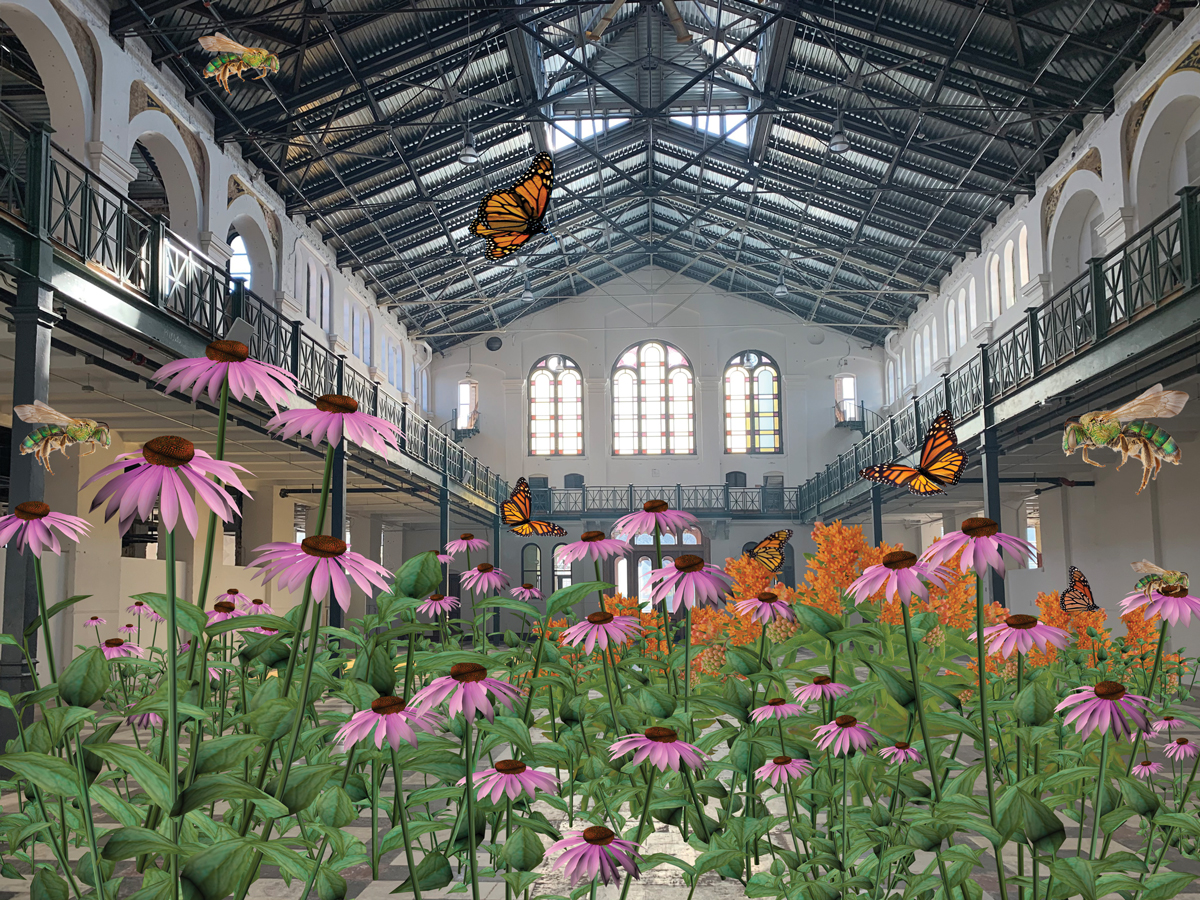 A rendering of Tamiko Thiel and /p’s project ReWildAR for the Smithsonian. Courtesy the artists Tamiko Thiel x Entomologist Holly Walker
A rendering of Tamiko Thiel and /p’s project ReWildAR for the Smithsonian. Courtesy the artists Tamiko Thiel x Entomologist Holly Walker
Washington, D.C., is one of the most human-designed places on the planet: what used to be a swampy coast is now covered by streets laid in a grid and named by letter, all contained within a loop of highways. But the Smithsonian Institution is working to bring some simulated wildness to the area.
As part of the 175th anniversary celebration of the complex’s Arts and Industries Building (the red-spired beauty on Jefferson Drive), the Institution commissioned a new collaboration between Tamiko Thiel, a digital artist with a particular interest in virtual reality, and Holly Walker, an entomologist whose work includes managing the Smithsonian’s grounds and gardens. For a work to be included in an exhibition titled “Futures” opening in November, Thiel (along with fellow collaborative artist Peter Graf, who works under the name /p) created the initial vision for a “rewilded” D.C. and, in partnership with Walker, conceived an alternate-reality view of the environment the Smithsonian calls home. The installation, titled ReWildAR, will enlist augmented-reality technology to place real-life plants and animals in the world of smartphone and tablet screens.
“Think of these mobile devices as AR-scopes through which you peer into another dimension,” Thiel and Walker wrote together in response to questions. “You are not looking at an ‘image’ on your phone—you are looking through your screen into a speculative vision of the future.”
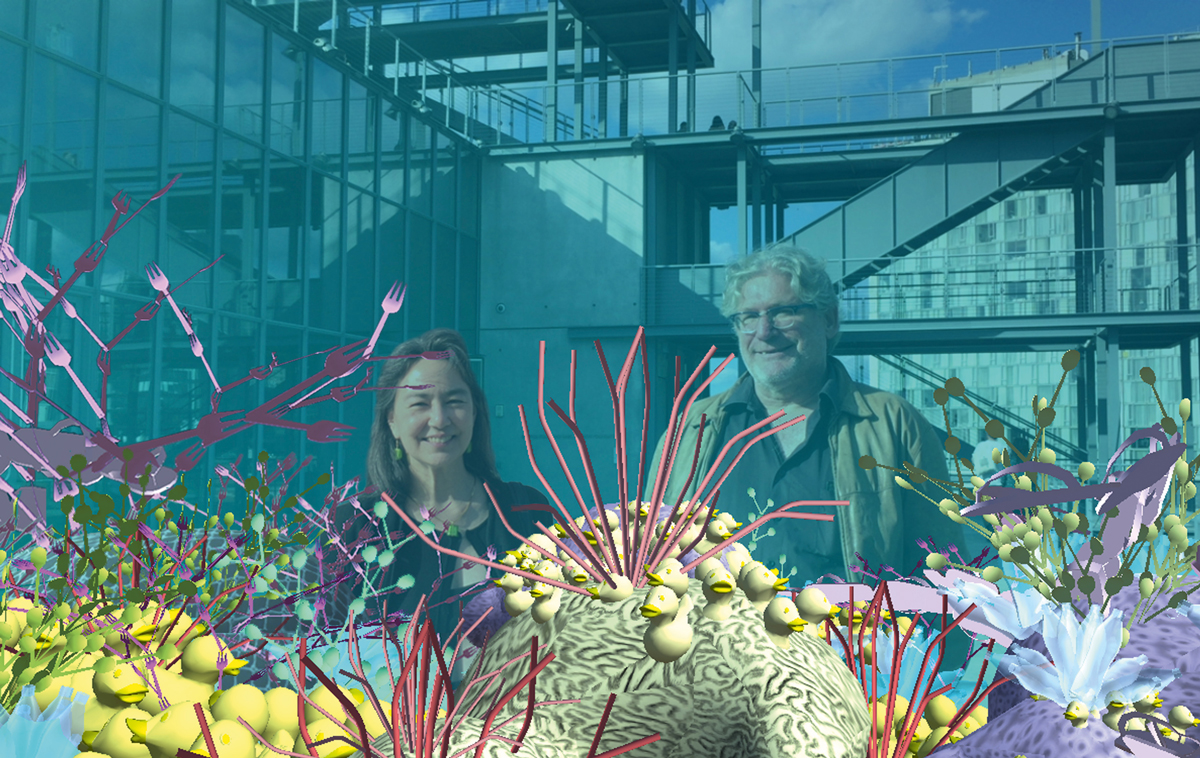 Tamiko Thiel and /p with their work Unexpected Growth at the Whitney Museum of American Art in 2018. Courtesy the artists
Tamiko Thiel and /p with their work Unexpected Growth at the Whitney Museum of American Art in 2018. Courtesy the artists
A portion of the exhibition will be filled with virtual flora and fauna based on the real-world plants and insects that are native to the Chesapeake Bay area. Said Thiel and Walker: “‘Rewilding’ the city means transforming all available open areas [including parks and rooftops] from carefully mono-cultivated gardens into wildflower meadows, wetlands, and natural habitats teeming with biodiversity.”
Because climate change is predicted to make Washington even warmer and more humid than it is currently, local flora and fauna will, in the not-too-distant future, come to resemble something more like that in Georgia or Florida. ReWildAR will account for that with the presence of plants and insects indigenous not just to D.C. but to points farther south. “Visitors will be able to see the Arts and Industries Building become an expansive meadow, [with] metallic green sweat bees swarming around echinacea flowers and monarch butterflies fluttering among the milkweed,” Thiel and Walker said.
While experts have been sounding the alarm over climate change, habitat destruction, and biodiversity loss for decades, there remains a gap between what scientists know and what they can communicate—between what people hear and what they absorb, as identified by the phenomenon known as the “knowledge gap.” But augmented-reality art can help, Walker said: “People tend to absorb information better when it is presented in an enjoyable medium, and AR allows people to interact with the world but also feel as if they are a part of the exhibit. Active participation can sometimes be lost in other mediums, and triggers healthy curiosity at all ages.”
Thiel, for her part, said she finds clarity and harmony in the intersection between science and art—especially helpful in a literally and figuratively gridlocked place like Washington. “I find the insights from science, in this instance from Holly, to be as wondrous as any insights that art can bring,” she noted. “As Dante is alleged to have said, ‘Nature is the art of God.’”
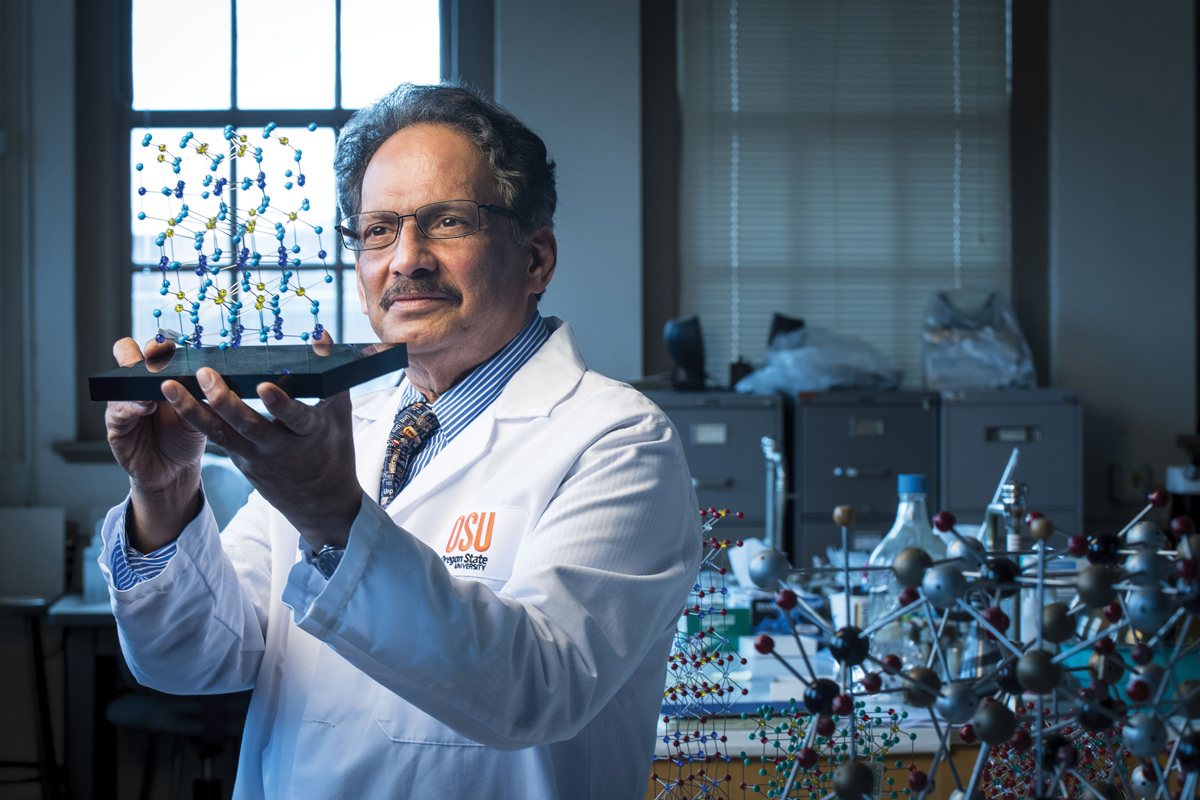 Mas Subramanian holding a molecular model of YInMn blue in his lab at Oregon State University. Photo Karl Maasdam/Courtesy Oregon State University YInMn Blue x Canvas
Mas Subramanian holding a molecular model of YInMn blue in his lab at Oregon State University. Photo Karl Maasdam/Courtesy Oregon State University YInMn Blue x Canvas
It took more than 10 years for the newest blue pigment to go from accidental laboratory find to a color fit for the art world. It was discovered in 2009 in a lab at Oregon State University, where chemist Mas Subramanian and his team were endeavoring to create inorganic materials for use in electronics. When graduate student Andrew Smith took a new compound out of an oven heated to more than 2,000 degrees, he found it to be of an intense, shocking blue.
The color’s vibrancy comes from a mix of elements: yttrium, indium, and manganese oxides. Common in electronics, LEDs, and semiconductors, yttrium and indium are lustrous metals—yttrium is a “rare-earth element”—that are soft enough in their pure form to cut with a knife.
The first new inorganic blue discovered in two centuries, the intensity of the eye-popping color, called YInMn blue (for the letters of the elements it contains), can be modified by adjusting the ratio of indium to manganese. After the discovery in his lab, Subramanian entered a nondisclosure agreement with the Ohio-based Shepherd Color Company, which began testing YInMn blue’s properties for commercial use. The industrial value of the pigment lies in its ability to repel most infrared radiation, thereby keeping cool whatever material it covers, and since 2017, it has been available as an ingredient in plastics and industrial coatings for that very purpose. The color’s stability over time is also crucial to industry and artists alike. The researchers in Subramanian’s lab are now working to produce other such pigments in a range of colors from green to turquoise to purple to orange. A red pigment with similar qualities remains elusive.
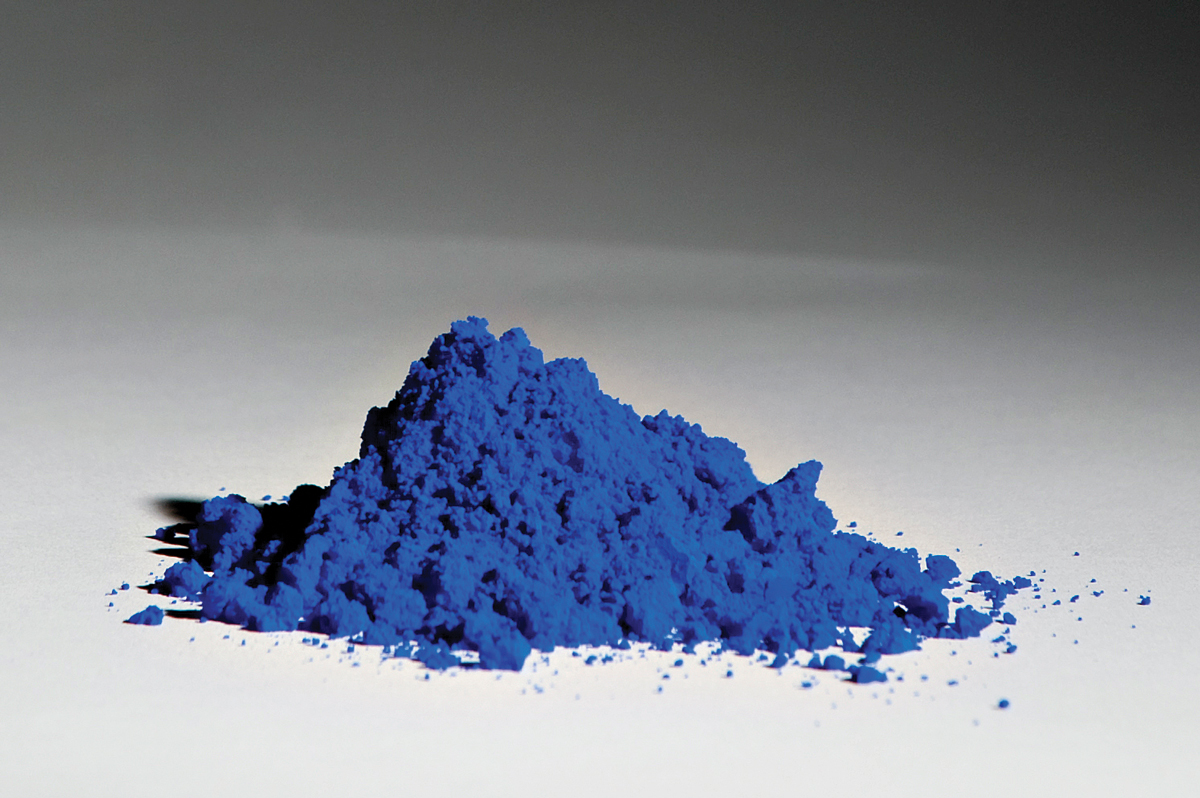 A pile of YInMn blue pigment. Photo Karl Maasdam/Courtesy Oregon State University
A pile of YInMn blue pigment. Photo Karl Maasdam/Courtesy Oregon State University
Michael Rothman, a longtime illustrator for museums as well as books and magazines whose website describes his work as “art to explain science,” has experimented with milling the new pigment to use in work depicting flora and fauna, including the blue plumage of an extinct genus of bird. “The other blue pigment I was milling in order to make an acrylic paint was a cobalt blue, and I had a much harder time producing a fully dispersed paint than I did with the YInMn blue,” Rothman told ARTnews. “I got a much smoother paint with YInMn than the cobalt blue I happened to be working with at the same time.”
Ken Fujimatsu is a painter based in Japan who uses paint made with the pigment by the Australian art supply company Derivan, which licensed the color for sale in an arrangement similar to Shepherd’s. Fujimatsu spoke highly of its technical properties. “When mixed with other colors or with white, it gives a beautiful, unobtrusive color,” he said. “I sometimes mix it with burnt umber to create a blackish color, which is a good substitute for black, but I find it easier to use than ultramarine because it has more hiding power.”
Meanwhile, YInMn blue is spreading far and wide: sales related to both industrial and artistic use, the Shepherd Color Company said, have doubled each of the last three years.
A version of this article appears in the August/September 2021 issue of ARTnews, under the title “Art X Science.”
Source link : https://www.artnews.com/art-news/artists/art-science-collaborations-pacific-standard-time-tba21-academy-1234603682












